Yingtao Jiang
Development of a Platform to Enable Real Time, Non-disruptive Testing and Early Fault Detection of Critical High Voltage Transformers and Switchgears in High Speed-rail
Oct 01, 2024Abstract:Partial discharge (PD) incidents can occur in critical components of high-speed rail electric systems, such as transformers and switchgears, due to localized insulation defects that cannot withstand electric stress, leading to potential flashovers. These incidents can escalate over time, resulting in breakdowns, downtime, and safety risks. Fortunately, PD activities emit radio frequency (RF) signals, allowing for the development of a hardware platform for real-time, non-invasive PD detection and monitoring. The system uses an RF antenna and high-speed data acquisition to scan signals across a configurable frequency range (100MHz to 3GHz), utilizing intermediate frequency modulation and sliding frequency windows for detailed analysis. When signals exceed a threshold, the system records the events, capturing both raw signal data and spectrum snapshots. Real-time data is streamed to a cloud server, offering remote access through a dedicated smartphone application, enabling maintenance teams to monitor and respond promptly. Laboratory testing has confirmed the system's ability to accurately capture RF signals and provide real-time PD monitoring, enhancing the reliability and safety of high-speed rail infrastructure.
Toward Precise Robotic Weed Flaming Using a Mobile Manipulator with a Flamethrower
Jul 06, 2024Abstract:Robotic weed flaming is a new and environmentally friendly approach to weed removal in the agricultural field. Using a mobile manipulator equipped with a flamethrower, we design a new system and algorithm to enable effective weed flaming, which requires robotic manipulation with a soft and deformable end effector, as the thermal coverage of the flame is affected by dynamic or unknown environmental factors such as gravity, wind, atmospheric pressure, fuel tank pressure, and pose of the nozzle. System development includes overall design, hardware integration, and software pipeline. To enable precise weed removal, the greatest challenge is to detect and predict dynamic flame coverage in real time before motion planning, which is quite different from a conventional rigid gripper in grasping or a spray gun in painting. Based on the images from two onboard infrared cameras and the pose information of the flamethrower nozzle on a mobile manipulator, we propose a new dynamic flame coverage model. The flame model uses a center-arc curve with a Gaussian cross-section model to describe the flame coverage in real time. The experiments have demonstrated the working system and shown that our model and algorithm can achieve a mean average precision (mAP) of more than 76\% in the reprojected images during online prediction.
Data Streaming and Traffic Gathering in Mesh-based NoC for Deep Neural Network Acceleration
Aug 01, 2021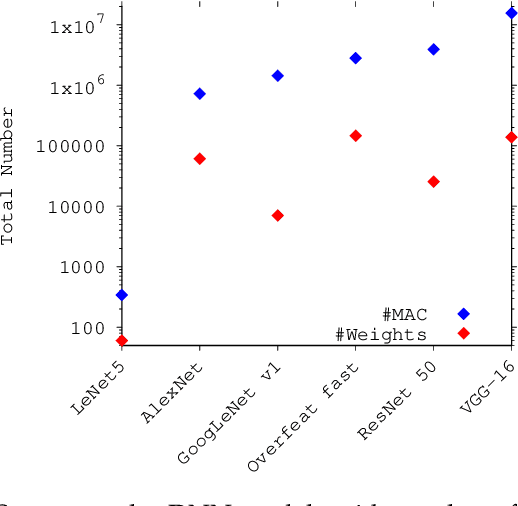
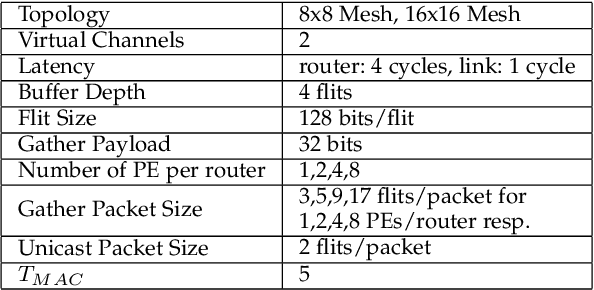
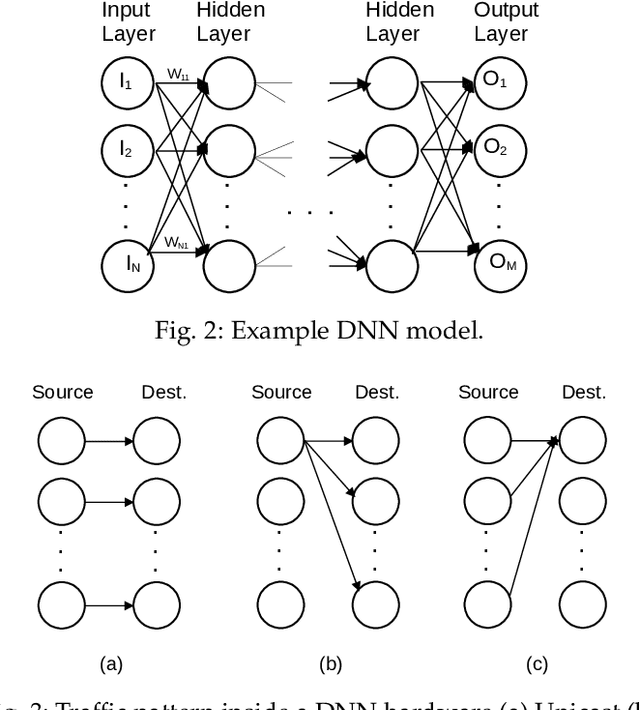
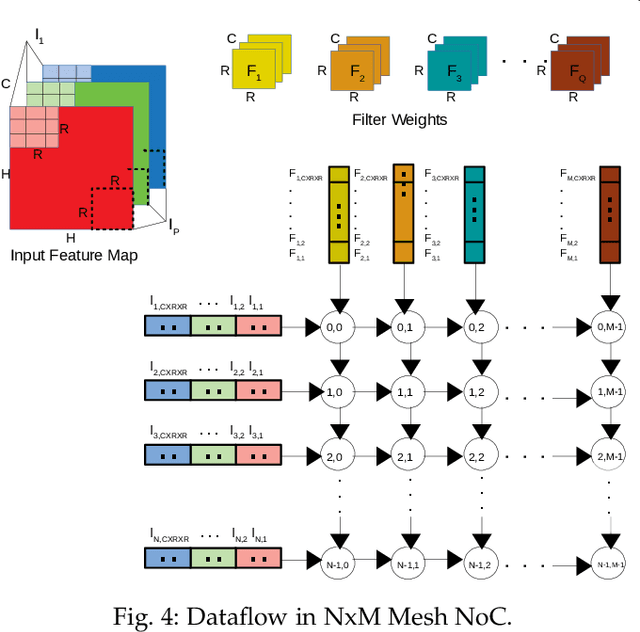
Abstract:The increasing popularity of deep neural network (DNN) applications demands high computing power and efficient hardware accelerator architecture. DNN accelerators use a large number of processing elements (PEs) and on-chip memory for storing weights and other parameters. As the communication backbone of a DNN accelerator, networks-on-chip (NoC) play an important role in supporting various dataflow patterns and enabling processing with communication parallelism in a DNN accelerator. However, the widely used mesh-based NoC architectures inherently cannot support the efficient one-to-many and many-to-one traffic largely existing in DNN workloads. In this paper, we propose a modified mesh architecture with a one-way/two-way streaming bus to speedup one-to-many (multicast) traffic, and the use of gather packets to support many-to-one (gather) traffic. The analysis of the runtime latency of a convolutional layer shows that the two-way streaming architecture achieves better improvement than the one-way streaming architecture for an Output Stationary (OS) dataflow architecture. The simulation results demonstrate that the gather packets can help to reduce the runtime latency up to 1.8 times and network power consumption up to 1.7 times, compared with the repetitive unicast method on modified mesh architectures supporting two-way streaming.
Improving the Performance of a NoC-based CNN Accelerator with Gather Support
Aug 01, 2021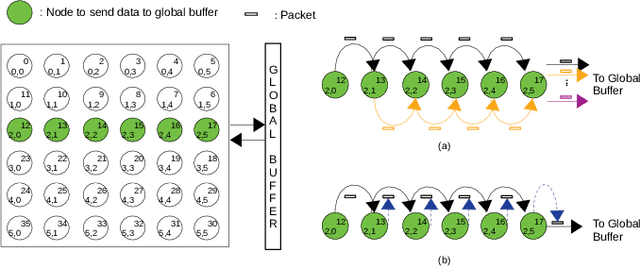
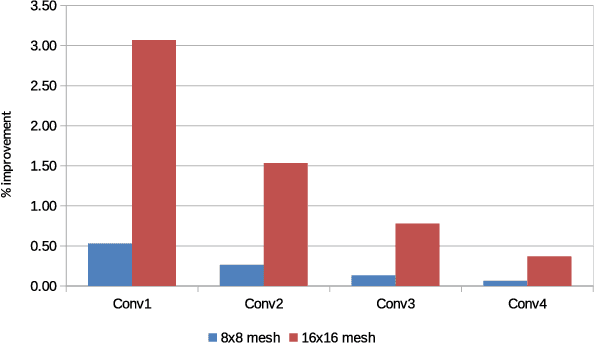
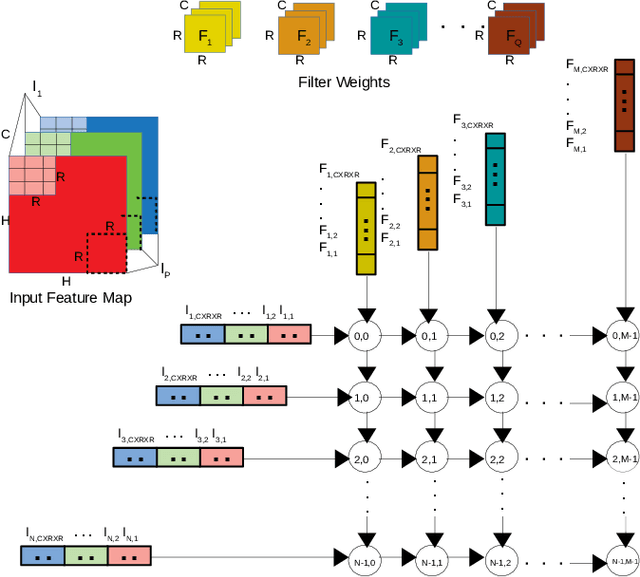

Abstract:The increasing application of deep learning technology drives the need for an efficient parallel computing architecture for Convolutional Neural Networks (CNNs). A significant challenge faced when designing a many-core CNN accelerator is to handle the data movement between the processing elements. The CNN workload introduces many-to-one traffic in addition to one-to-one and one-to-many traffic. As the de-facto standard for on-chip communication, Network-on-Chip (NoC) can support various unicast and multicast traffic. For many-to-one traffic, repetitive unicast is employed which is not an efficient way. In this paper, we propose to use the gather packet on mesh-based NoCs employing output stationary systolic array in support of many-to-one traffic. The gather packet will collect the data from the intermediate nodes eventually leading to the destination efficiently. This method is evaluated using the traffic traces generated from the convolution layer of AlexNet and VGG-16 with improvement in the latency and power than the repetitive unicast method.
 Add to Chrome
Add to Chrome Add to Firefox
Add to Firefox Add to Edge
Add to Edge